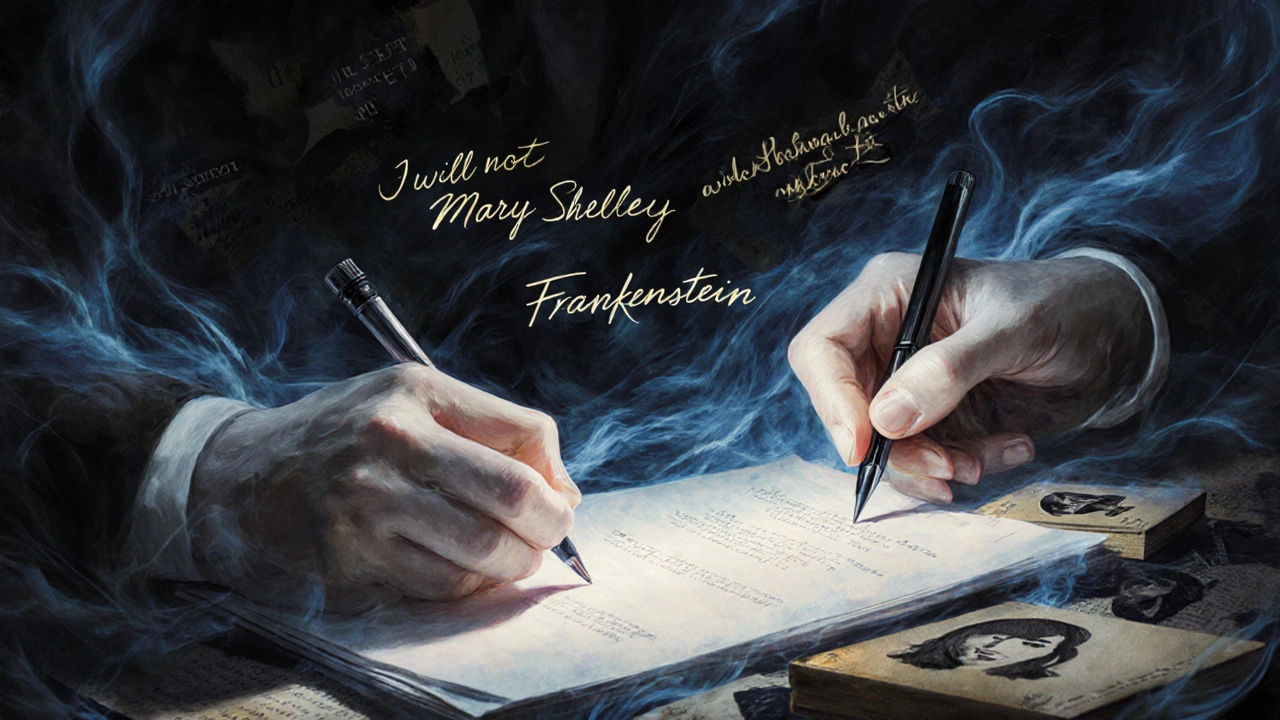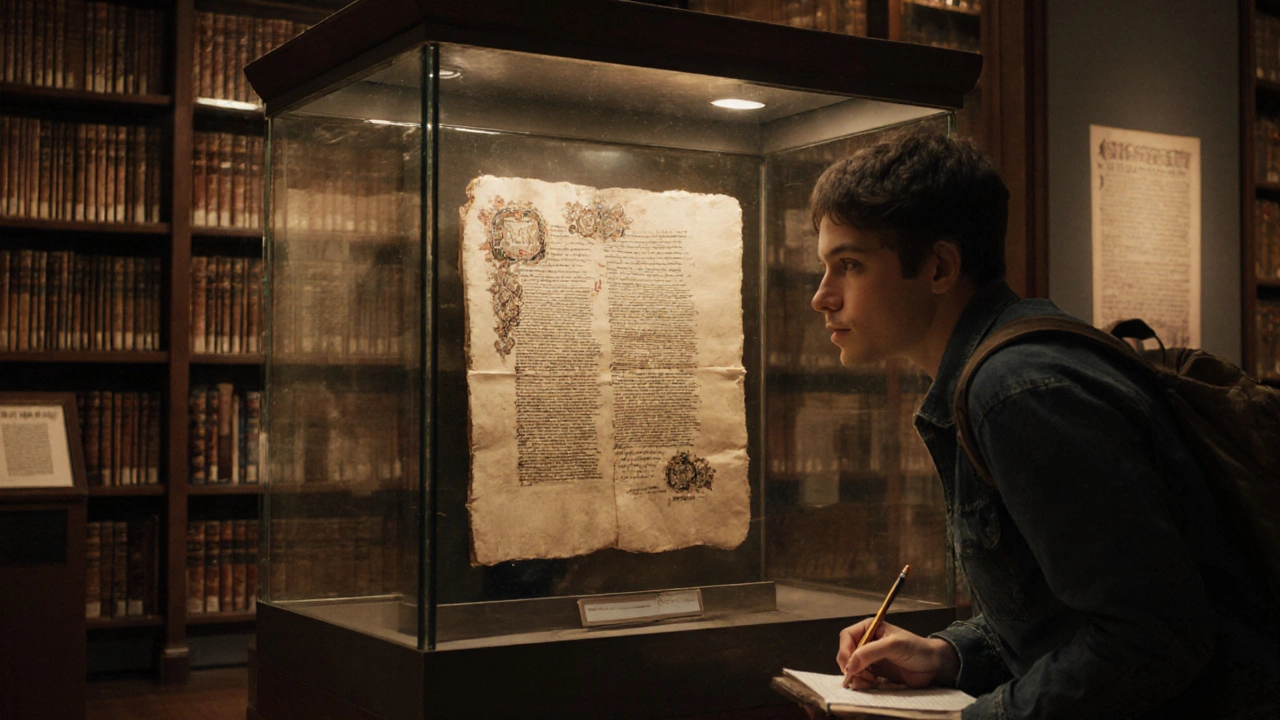The British Library in London isn’t just a building full of books-it’s a time machine. Walk through its doors and you’re standing in the same room where Charles Dickens scribbled edits, where Jane Austen’s handwritten drafts still hold the smudges of her pen, and where the only surviving copy of Beowulf rests under glass, nearly 1,200 years old. This isn’t a museum exhibit. This is the living archive of English literature, and you don’t need to be a scholar to see it.
What You’ll Find in the Manuscripts and Literary Collections
The British Library holds over 170 million items. Of those, around 160,000 are manuscripts-handwritten documents from the Middle Ages to today. These aren’t just old papers. They’re the raw, unedited thoughts of writers before they became legends.
Among the highlights:
- The Beowulf manuscript (c. 1000 AD), the oldest surviving epic poem in Old English
- Leonardo da Vinci’s notebooks, filled with sketches of flying machines and anatomical studies
- Anne Frank’s diary, handwritten in a small red-checkered notebook
- Handwritten lyrics by The Beatles, including the original draft of "Yesterday"
- Virginia Woolf’s diary entries, annotated with her own edits and marginalia
- Original letters from Oscar Wilde, Emily Brontë, and T.S. Eliot
These aren’t displayed all at once. The library rotates its exhibits, so you might see a Shakespeare First Folio one month and a 19th-century abolitionist pamphlet the next. But the collection never changes: it’s the largest and most complete literary archive in the world.
How to Access the Collections (Even If You’re Not a Researcher)
You don’t need a university ID to see these treasures. The British Library lets anyone over 18 register for a Reader Pass-and it’s free. All you need is a photo ID and proof of address (a utility bill, bank statement, or even a library card from another country).
Here’s how it works:
- Go to the British Library website and book a time slot for the Manuscripts Reading Room.
- Bring your ID and proof of address on your visit day.
- At the Registration Desk, fill out a short form and get your Reader Pass.
- Once registered, you can request items from the collections through the online catalogue.
Items are delivered to you in the Reading Room within 45 minutes. You can’t touch the originals-gloves aren’t needed, but you must use a book cradle and pencil-only notes. No pens. No bags. No phones in the reading area. These rules exist because these documents are irreplaceable.
Most visitors come to see one or two items. That’s fine. You don’t need to spend a week there. Spend an afternoon with the original draft of Lewis Carroll’s Alice’s Adventures Under Ground, and you’ll see how he crossed out "Alice" and wrote "Edith" before changing his mind.
Exhibitions You Can’t Miss
The British Library’s public exhibitions change every few months, but some are so iconic they return often.
Treasures of the British Library is always on display in the Sir John Ritblat Gallery. It’s free, no booking needed, and open daily from 10 a.m. to 5 p.m. You’ll find:
- The Magna Carta (1215), one of only four surviving originals
- Queen Elizabeth I’s personal copy of Erasmus’s In Praise of Folly, with her handwritten notes in the margins
- A page from the Gutenberg Bible, the first major book printed in Europe
- Original illustrations from Lewis Carroll’s Alice drawings
For literary fans, the Writing Britain exhibition explores how places like the Lake District, London’s East End, and the Scottish Highlands shaped British literature. You’ll see handwritten maps, letters from war poets, and the first draft of George Orwell’s 1984-complete with his handwritten edits to the ending.

What Makes These Collections Different from a Public Library?
A public library lends books. The British Library preserves history.
Every manuscript here was either donated, purchased, or legally deposited under UK law. Since 1709, every publisher in the UK has been required to send one copy of every printed book to the library. That’s why it has every novel, pamphlet, and poetry collection published in Britain for over 300 years.
It’s not just about famous authors. You can find:
- Letters from working-class soldiers in World War I
- Handwritten recipes from 18th-century London housewives
- Diaries of coal miners in Yorkshire
- Early fan letters to Charles Dickens
These aren’t footnotes. They’re the real voices behind the stories we read.
How to Prepare for Your Visit
Don’t walk in expecting to browse. The collections are stored off-site and must be requested in advance.
Use the Explore the British Library online catalogue. Search by author, title, or date. You can even filter by "manuscript" or "literary archive." When you find something, note the shelfmark-it’s the unique code like "Add MS 37049" that tells staff exactly where to pull it from.
Pro tip: If you’re interested in a specific writer, search their name + "papers" or "archive." You’ll often find entire collections-like the entire draft history of D.H. Lawrence’s Lady Chatterley’s Lover, including rejected chapters.
Bring a notebook and pencil. No laptops or cameras in the reading rooms. But you can take photos of documents with your phone if you ask permission and use the library’s free lighting setup.

Why This Matters Beyond Literature
These manuscripts aren’t just old handwriting. They’re evidence of how ideas change.
Look at the original draft of Frankenstein by Mary Shelley. You’ll see her husband Percy’s edits in a different ink. He crossed out entire paragraphs. She wrote back in the margins: "I will not change this." That’s not just editing-it’s a fight over voice, gender, and control.
Or study the letters between Sylvia Plath and Ted Hughes. You’ll see how love, jealousy, and creative rivalry shaped two of the 20th century’s greatest poets.
These aren’t relics. They’re conversations. And you’re allowed to listen.
What to Do After Your Visit
Many items have been digitized. If you can’t visit in person, you can view high-resolution scans of thousands of manuscripts for free on the British Library’s website. Try searching for "Digitised Manuscripts" on their site.
For deeper dives, check out their free online courses: "How to Read a Medieval Manuscript" or "Writing the Self: Diaries and Letters in English Literature." They’re taught by actual archivists.
And if you’re inspired? Write your own letter. The library accepts modern literary donations. You never know-100 years from now, someone might be reading your notebook, wondering who you were.
Can I touch the original manuscripts at the British Library?
No, you cannot touch the original manuscripts. They are too fragile and valuable. You’ll view them under supervised conditions in the Reading Room, using book cradles and pencil-only notes. Gloves are not required-clean hands are enough. The library uses special lighting and handling tools to protect the documents while letting you see every detail.
Do I need to be a student or researcher to visit?
No. Anyone over 18 with a photo ID and proof of address can get a free Reader Pass. You don’t need to be enrolled in a university or working on a thesis. Many visitors come just to see a single manuscript-like the original draft of "Yesterday" by The Beatles or Anne Frank’s diary. The library welcomes the public.
How long does it take to get a manuscript after I request it?
It usually takes 45 minutes to an hour. You request items online before your visit or at the Reading Room terminals. Once requested, staff retrieve the item from secure storage and deliver it to your desk. You can request up to three items per day. Plan ahead-popular items like the Beowulf manuscript may need to be booked weeks in advance during peak seasons.
Are there free exhibitions I can see without a Reader Pass?
Yes. The Sir John Ritblat Gallery is open daily from 10 a.m. to 5 p.m. and doesn’t require a pass. It features rotating displays of the library’s most famous items, including the Magna Carta, the Gutenberg Bible, and original illustrations from Alice in Wonderland. You can walk in anytime during opening hours-no booking needed.
Can I take photos of the manuscripts?
You can take photos of most manuscripts with your phone, but you must ask permission first. The library provides free, non-flash lighting stations for visitors who want to photograph documents. No tripods or professional equipment are allowed. Photos are for personal use only-you can’t publish or sell them without written permission from the library.
Final Thought: The Quiet Power of Handwritten Words
Most people think of London as skyscrapers, Tube stations, and busy streets. But if you take the 10-minute walk from St. Pancras station to the British Library, you step into another London-one where time slows down. Here, the past isn’t preserved behind glass. It’s alive in ink, in erasures, in the pressure of a pen that once belonged to someone who changed the world.
You don’t need to be a writer to feel that. You just need to show up.
